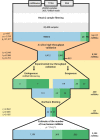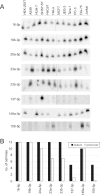An estimate of the total number of true human miRNAs
- PMID: 30820533
- PMCID: PMC6468295
- DOI: 10.1093/nar/gkz097
An estimate of the total number of true human miRNAs
Abstract
While the number of human miRNA candidates continuously increases, only a few of them are completely characterized and experimentally validated. Toward determining the total number of true miRNAs, we employed a combined in silico high- and experimental low-throughput validation strategy. We collected 28 866 human small RNA sequencing data sets containing 363.7 billion sequencing reads and excluded falsely annotated and low quality data. Our high-throughput analysis identified 65% of 24 127 mature miRNA candidates as likely false-positives. Using northern blotting, we experimentally validated miRBase entries and novel miRNA candidates. By exogenous overexpression of 108 precursors that encode 205 mature miRNAs, we confirmed 68.5% of the miRBase entries with the confirmation rate going up to 94.4% for the high-confidence entries and 18.3% of the novel miRNA candidates. Analyzing endogenous miRNAs, we verified the expression of 8 miRNAs in 12 different human cell lines. In total, we extrapolated 2300 true human mature miRNAs, 1115 of which are currently annotated in miRBase V22. The experimentally validated miRNAs will contribute to revising targetomes hypothesized by utilizing falsely annotated miRNAs.
© The Author(s) 2019. Published by Oxford University Press on behalf of Nucleic Acids Research.
Figures




References
-
- Ambros V. The functions of animal microRNAs. Nature. 2004; 431:350–355. - PubMed
-
- Bartel D.P. MicroRNAs: genomics, biogenesis, mechanism, and function. Cell. 2004; 116:281–297. - PubMed
-
- Hart M., Nolte E., Wach S., Szczyrba J., Taubert H., Rau T.T., Hartmann A., Grasser F.A., Wullich B.. Comparative microRNA profiling of prostate carcinomas with increasing tumor stage by deep sequencing. Mol. Cancer Res. 2014; 12:250–263. - PubMed
-
- Petriella D., De Summa S., Lacalamita R., Galetta D., Catino A., Logroscino A.F., Palumbo O., Carella M., Zito F.A., Simone G. et al. .. miRNA profiling in serum and tissue samples to assess noninvasive biomarkers for NSCLC clinical outcome. Tumour Biol. 2016; 37:5503–5513. - PubMed
Publication types
MeSH terms
Substances
LinkOut - more resources
Full Text Sources
Other Literature Sources

